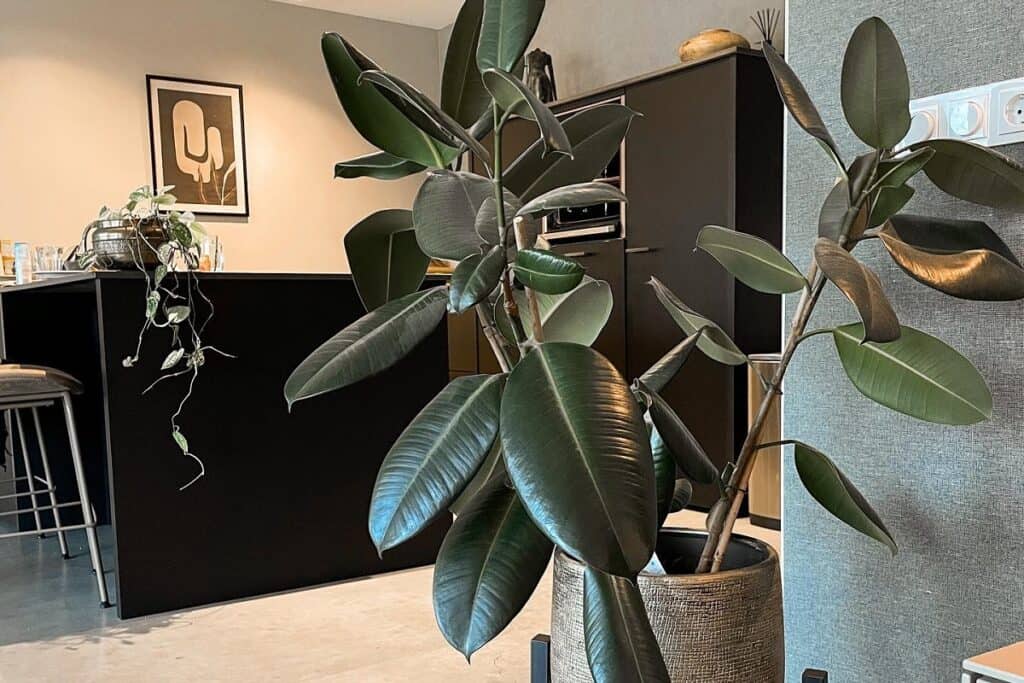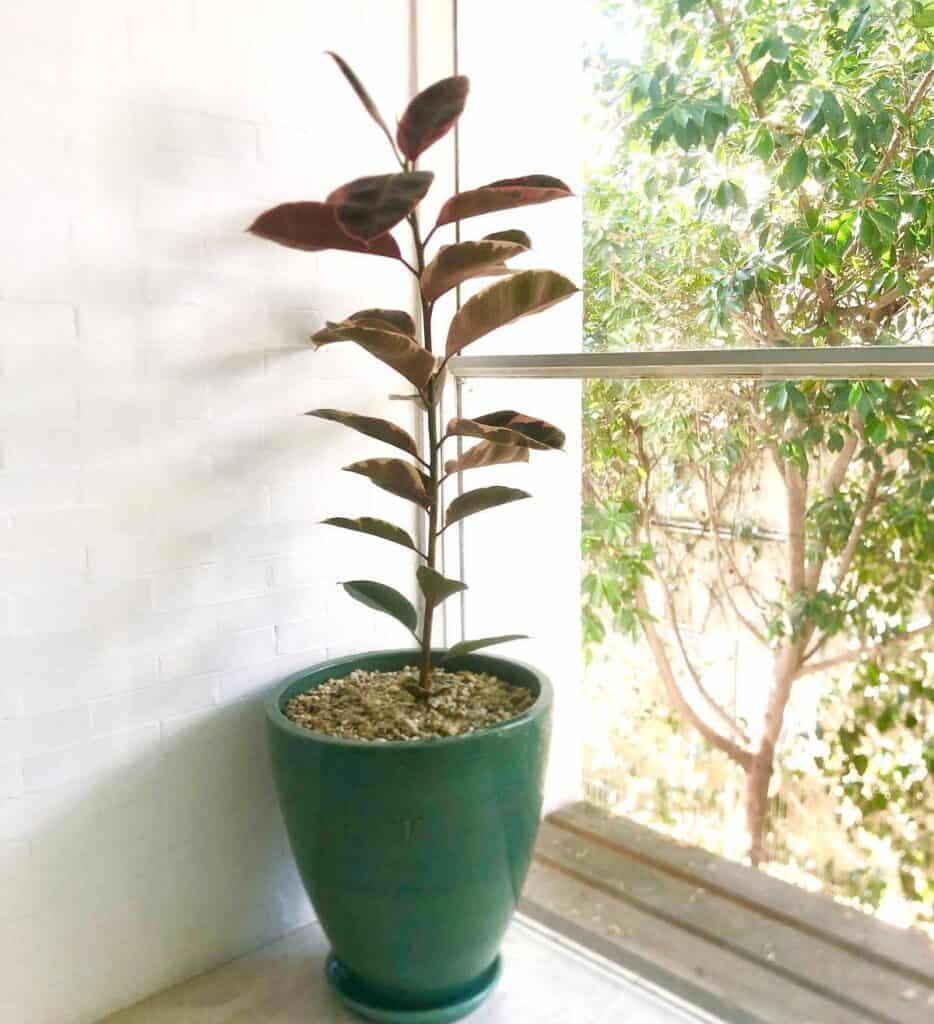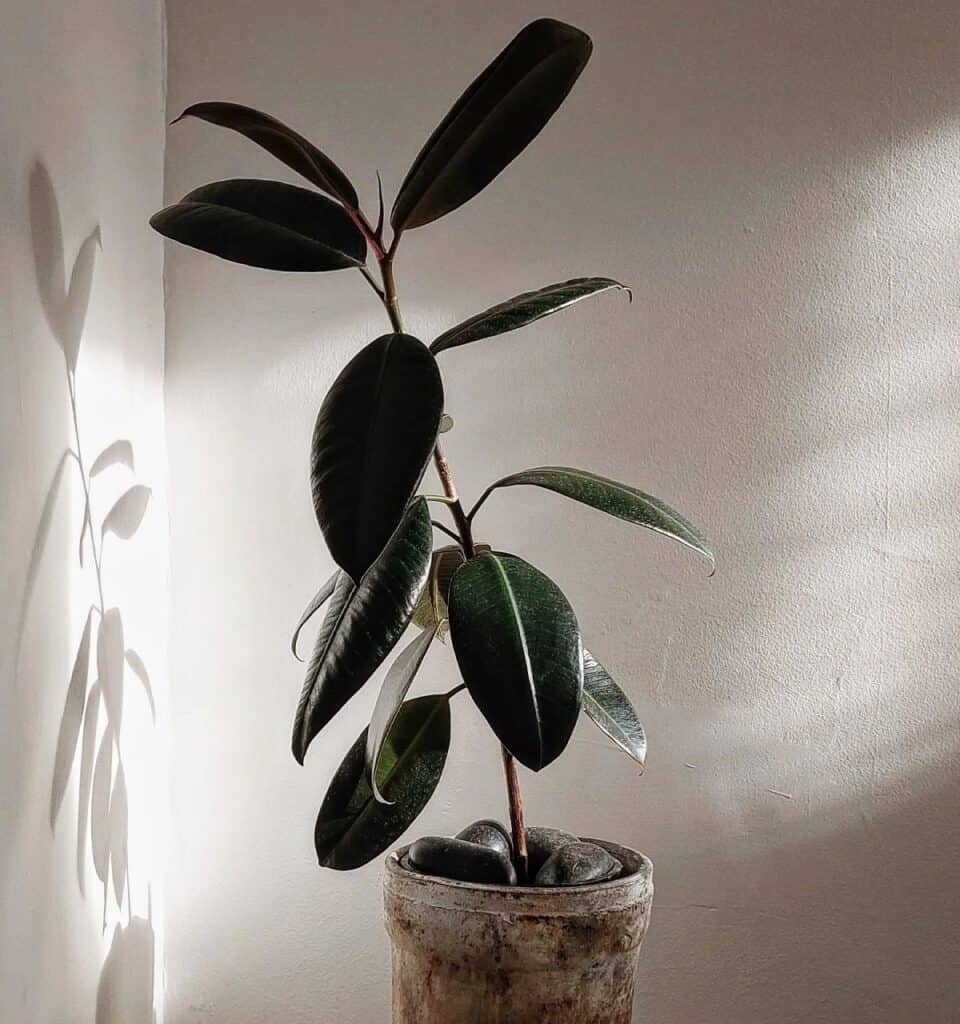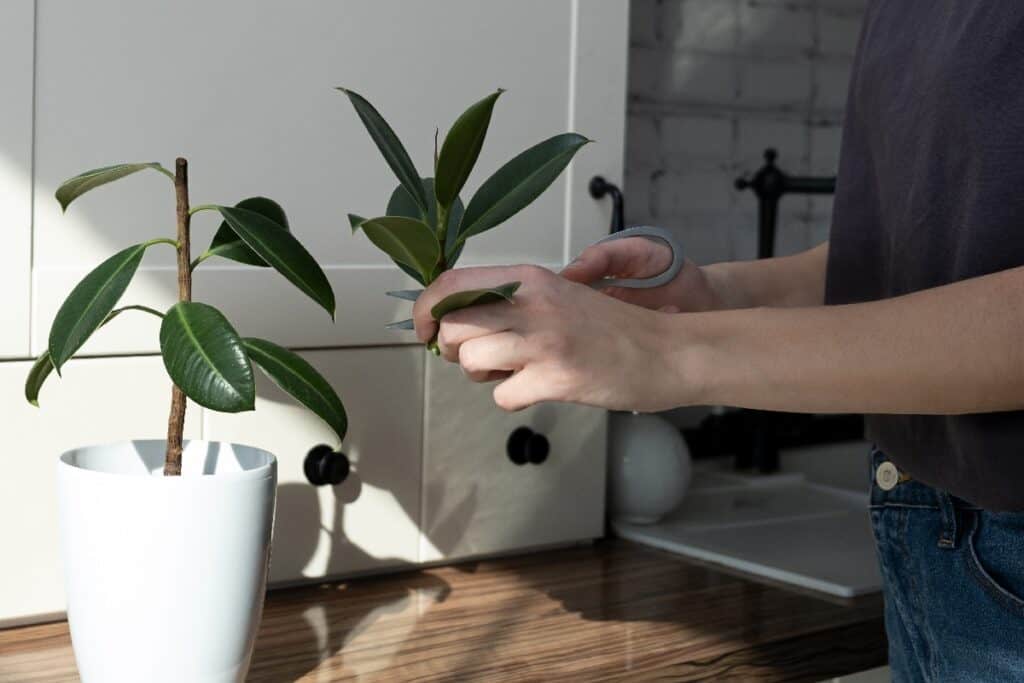If you’ve ever found yourself frustrated with a leggy rubber plant, you’re not alone. The common plant is notorious for becoming thin and stretched out when not properly cared for. It’s easy to take the blame when this happens, but the truth is that the rubber plant’s legginess is actually caused by a few different things.
Are you ready to understand the causes of a leggy rubber plant and discover solutions to help?

Contents
Common Causes Of Leggy Rubber Plant
Rubber plants, also known as Ficus Elastica, are a popular houseplant known for their thick and glossy leaves. However, when the plant does not receive enough light, it can become leggy, which means that the leaves are sparse and long stems have become exposed. If not given adequate attention, the plant will continue to stretch and become weak.
The most common cause of leggy rubber plants is inadequate light. The plant needs bright, indirect light to stay healthy and encourage new growth. If the plant is placed in an area that receives too little light, the stems will become tall and the leaves will become sparse. In some cases, the plant will stretch towards the light source, revealing its long, thin stems.
In addition to a lack of light, a rubber plant can become leggy if it receives too much water. Overwatering the plant can cause stem rot and will prevent new growth from occurring. If the plant is overwatered, the leaves will turn yellow and become sparse, revealing the long stems underneath.
Finally, a rubber plant can become leggy if it is not pruned regularly. When a plant is not pruned, the stems will continue to stretch and become weak. Pruning encourages new growth and helps to keep the plant healthy and strong.
Solutions To Prevent Leggy Rubber Plant

1. Provide plenty of light: Rubber plants need bright, indirect sunlight to thrive and prevent legginess. Position the plant near a window that gets plenty of light, but not direct sunlight.
2. Prune: Prune the plant regularly to control leggy rubber plants and encourage new growth. Remove any dead, damaged, or leggy branches to help the plant conserve energy for new growth.
3. Fertilize: Feed the plant with a balanced fertilizer once a month during the growing season. This will help the plant stay healthy and encourage new growth.
4. Repot: Repot the plant into a larger pot every couple of years. This will provide the roots with more room to grow and will help keep the plant from becoming rootbound.
5. Reduce watering: Reduce watering during the winter months to allow the plant to rest. Water only when the soil is dry and never allow the plant to sit in standing water.
Ways To Improve Light Conditions
One way to improve light conditions for a leggy rubber plant is to move it closer to a window. If it is not possible to move the plant physically, another way is to provide supplemental lighting. This can be done by using artificial grow lights that provide the right type of light spectrum for the plant. The intensity and duration of the light can be adjusted to provide the ideal light conditions for the plant.
Finally, pruning can be used to improve light conditions for a leggy rubber plant. Pruning can be used to reduce the amount of foliage on the plant, which will help to allow more light to reach the lower parts of the plant. This will help the plant to receive more even lighting, which can help to reduce the chances of the plant becoming leggy.
Tips For Proper Watering
When it comes to watering your leggy rubber plant, there are a few tips to keep in mind. Firstly, you should water your rubber plant deeply and thoroughly every time you water it. This will help to ensure that the soil is evenly moist, which is essential for your rubber plant’s healthy growth. Secondly, you should make sure to check the soil’s moisture content before watering. If the top few inches of soil are dry, then the plant needs water. Otherwise, wait a few more days and check again.
Thirdly, it is important to avoid overwatering your rubber plant. Overwatering can lead to root rot, which can be difficult to treat and can damage your rubber plant’s roots. When in doubt, err on the side of underwatering. Lastly, you should water your rubber plant in the morning so that the leaves can dry off by the evening. This will help to prevent fungal diseases, which can be caused by excess moisture on the leaves.

Benefits Of Pruning
Pruning is an essential part of caring for a leggy rubber plant. It not only helps keep the overall shape of the plant, but it also helps maintain its health. Here are five benefits of pruning a leggy rubber plant.
First, pruning encourages new growth. Removing old, leggy stems and leaves will help promote the growth of new, healthier stems and foliage. This is especially beneficial for a rubber plant, as it will help keep its shape and overall appearance.
Second, pruning helps to improve the quality of the rubber plant’s foliage. Removing excess foliage helps to reduce overcrowding and allows for better air circulation. This can help to reduce the chances of disease and pests.
Third, pruning helps to control the size of a rubber plant. If the plant is growing too tall, pruning can help to keep it at a manageable size and shape. This can be especially beneficial for those with limited space.
Fourth, pruning helps to maintain the overall health of the rubber plant. Removing dead or diseased stems and leaves will help to stop the spread of disease and can help keep the plant healthy and vibrant.
Finally, pruning is a great way to keep a rubber plant looking its best. By removing any dead, leggy, or diseased stems and foliage, the overall appearance of the plant will be improved, making it look more aesthetically pleasing.
Related Post:
17 Amazing Rubber Plant Benefits
How To Propagate An Leggy Rubber Plant
Propagating a leggy rubber plant is a great way to create new plants for your home or garden. The process is simple and requires few materials. All you need is a pair of sharp scissors, a rooting hormone, and some potting soil.
To start, carefully cut a stem from the parent plant, just below a node. This is the area where the leaves and branches grow. The stem should be at least 4-5 inches long and contain at least two nodes. When cutting the stem, make sure to use sharp scissors and cut at a 45-degree angle. This will ensure a clean cut.

Next, take the stem and dip it in the rooting hormone. This will help promote root growth. Once the stem has been dipped, plant it in some potting soil. Be sure to water the soil before planting and make sure the stem is buried up to the first node.
Finally, place the pot in a warm, sunny spot and keep the soil moist. It can take anywhere from 2-6 weeks for the stem to take root. Once the roots are established, the new plant can be transplanted into a larger pot or into your garden. With patience and care, your rubber plant will soon be thriving!
Best Growing Conditions For Rubber Plants To Avoid Leggy Growth
Rubber plants (Ficus elastica) are attractive and popular plants that can bring life to any indoor space. Although they are resilient and easy to care for, they do require the right growing conditions to avoid spindly, leggy growth.
The best growing conditions for rubber plants include bright, indirect light. Direct sunlight will scorch the leaves, so avoid placing the plant in direct sun. Too little light, on the other hand, will cause the plant to stretch and become leggy. To keep the plant from stretching, find a spot where it can get indirect light for several hours a day.
Rubber plants also need regular watering, but not too much. The soil should be kept evenly moist but not soggy, as overwatering can lead to root rot. Make sure the pot has adequate drainage and empty out any standing water. It is also important to fertilize the plant regularly, as this will help it stay lush and full.
Finally, rubber plants need to be pruned regularly to maintain a healthy shape and avoid leggy growth. Prune the plant to remove any dead or damaged leaves, as well as any stems that have become too long or spindly. Pruning will encourage the plant to produce new growth and help keep it looking its best. With the right care and attention, rubber plants can provide a long-lasting and attractive addition to your home.
Conclusion
The rubber plant is a beautiful and easy-to-care-for houseplant, however, it can be susceptible to certain issues. Fortunately, it is easy to diagnose and treat the problem behind leggy rubber plants. By providing it with the correct amount of light and water, regularly removing any dead leaves or stems, and pruning the stems when necessary, you can ensure your rubber plant is bushy and happy for years to come.
